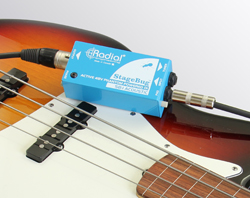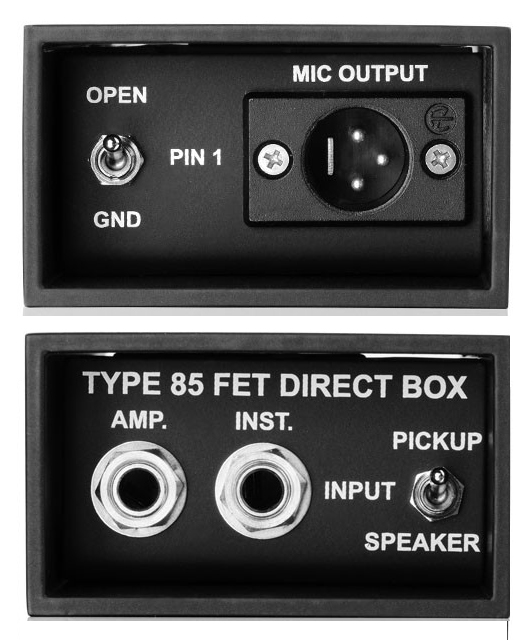
Active DI Units
An active DI contains a preamplifier. Active DIs can provide gain and are more complex yet versatile than passive units.
Active DIs require a power source, via batteries or a standard AC outlet connection, and may contain the option for phantom power use. Cheaper units offering both options may perform far better on fresh batteries than on phantom power, or vice versa, so it is important to test a prospective purchase in the mode in which it will be used.
Most active DIs provide switches to enhance versatility. These include gain or level adjustment, ground lift, power source selection, and mono/stereo mode. Ground-lift switches often (perhaps unintentionally) disconnect phantom power.
A pass-through connector is a second output, sometimes simply connected to the input connector, that delivers the input signal unchanged, to allow the DI to be inserted into a signal path without interrupting it. This is essential in many applications. Pass-through is common on active compared to passive DIs, and is commonly referred to as a bypass.
True bypass occurs when the signal goes straight from the input jack to the output jack with no circuitry involved and no loading of the source impedance. False-bypass or simply “bypass” occurs when the signal is routed through the device circuitry with no intentional change to the signal.
However, due to the nature of electrical designs there is almost always some slight change in the signal. The extent of change and how noticeable it may be can vary widely from unit to unit.
Typical Applications
Direct boxes are typically used in instances of instruments or other devices that only contain an unbalanced 1/4-inch output that needs to be connected to an XLR input.
Headphone Outputs. A DI can be used to receive a signal from any headphone jack, such as those on personal stereo systems or keyboards. If the signal is to be connected to a single input then a mixing facility is required in the DI unit. If stereo is required, then either two DI units or a single stereo unit can be used. The jack cannot normally be used for headphones as well.
Suitable units:
Active
Passive resistive load
Acoustic Or Electric Instruments. DIs can be used on instruments with electronic circuitry and pick ups that do not contain an XLR balanced output. An example of this application would be an electric keyboard that needs to be connected to a mixer board, either directly or through a snake. Another example would be an acoustic guitar with pickups or an electric guitar or bass guitar that would be mixed through a mixing console into a main or monitor mix.
Electric Keyboards. For best results use the line output(s), unless the keyboard has built-in balanced outputs (some high end units only) which are essentially built-in DI units and should give the best results of all. If monitor amplifiers are also to be driven directly from the keyboard, the DI unit must have a passthrough connector. Alternatively, take a signal from the amplifier instead, see below.
Suitable units:
Active
Passive balun type
Electric Guitar. A DI can be used to take a line in from an electric guitar. When dealing with electric guitars and electric guitar amplifiers, better results will often (not always) be obtained by instead using a microphone in front of the loudspeaker. This is because the tone of the guitar is often shaped by the amplifier and speaker used in the setup. A DI in the chain before the speaker or amplifier will often result in a loss of fullness or pleasant tone.

